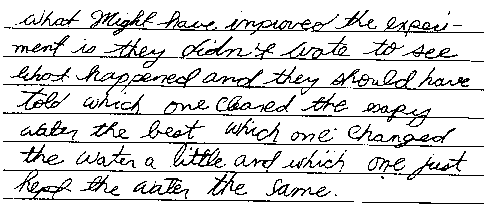|
Contributed by: Connecticut Academic Performance Test (CAPT)
Students in a science class were conducting experiments to explore
the use of various substances in removing soap from the water. One
way to remove soap from water is to have it react with other substances.
When the reactions occur, a solid called a precipitate is sometimes
formed. A precipitate can be filtered out of the water.
Group A carried out the following experiment.
- We put soapy water into three separate plastic cups.
- A different substance was added to each of the cups.
- After waiting five minutes, the mixture in each cup
was filtered.
- We examined the precipitate (which remained in the
filter paper) and the filtrate (which was in the test
tube) for each mixture.
|
The table below shows our results.
|
1 |
2 |
3 |
| Substance added to Soapy Water |
Epsom Salt |
Table Salt |
Sugar |
| Precipitate |
White, milky |
White, milky |
None |
| Filtrate |
Clear |
Slightly cloudy |
Cloudy |
Question 1 - Event Score = 0
Based on their results, Group A concluded that Epsom salt removed
the soap from the water. Is this a valid conclusion? Explain your
answer fully.

|
Component
|
Score
|
Commentary
|
|
Question 1
|
(0)
|
The response addresses the question in a very
limited way. There is little explanation as to why the conclusion
is valid. No considerations that might contribute to a lack
of validity of the conclusion are discussed. |
Question 2 - Event Score = 0
Do you have enough information to replicate Group A's experiment?
If you think so, explain what information you have. If you think not,
explain what other information you would need.

|
Component
|
Score
|
Commentary
|
|
Question 2
|
(0)
|
The response incorrectly states that there is
enough information to replicate the experiment. The explanation
as to the information that is provided is very vague, and therefore
the response does not receive a higher score. |
Group B carried out the following experiment.
- We placed 50 mL of soapy water into three plastic cups.
- We added 10 grams of sugar to cup 1, 10 grams of table
salt to cup 2, and 10 grams of Epsom salt to cup 3. We
mixed each with a plastic spoon.
- We filtered all three mixtures.
- We then poured the filtrate (remaining liquid) into
3 separate test tubes, shook them and measured the height
of the soap suds.
|
The table below shows our results.
| Cup |
Substance |
Final Soap Suds Height |
| 1 |
Sugar |
9.1 cm |
| 2 |
Table Salt |
1.2 cm |
| 3 |
Epsom Salt |
0.2 cm |
Question 3 - Event Score = 0
Group B did not include a control in their experiment. What would
be an appropriate control? Explain your answer fully, including how
the control might improve the experiment.

|
Component
|
Score
|
Commentary
|
|
Question 3
|
(0)
|
The response is on topic but addresses the question
in a very limited way. It fails to describe an appropriate control
for the experiment. |
Question 4 - Event Score = 0
Compare Group A's and Group B's experiments. Which experiment, if
either, is better designed? Explain your answer fully.

|
Component
|
Score
|
Commentary
|
|
Question 4
|
(0)
|
The response identifies very minor considerations
in the quality of the designs of the two experiments. None
of the important considerations are discussed. |
|





